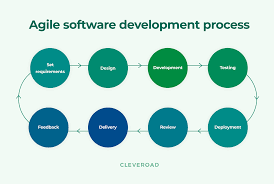Enhancing Business Resilience Through Effective Cyber Security Measures
The Importance of Cyber Security
In today’s digital age, cyber security has become a critical concern for individuals, businesses, and governments alike. With the increasing number of cyber threats and attacks targeting sensitive data and systems, the need for robust cyber security measures has never been more urgent.
Protecting Sensitive Information
Cyber security is essential for protecting sensitive information such as personal data, financial records, and intellectual property. Hackers and cyber criminals are constantly looking for vulnerabilities to exploit, making it crucial for individuals and organizations to safeguard their digital assets.
Preventing Data Breaches
Data breaches can have devastating consequences, resulting in financial losses, reputational damage, and legal implications. Implementing strong cyber security measures can help prevent unauthorized access to data and minimize the risk of data breaches.
Ensuring Business Continuity
For businesses, maintaining uninterrupted operations is vital for success. Cyber attacks such as ransomware can disrupt business activities and lead to significant downtime. By investing in cyber security solutions, organizations can ensure business continuity and minimize the impact of potential cyber threats.
Complying with Regulations
Many industries are subject to regulatory requirements regarding data protection and privacy. Failure to comply with these regulations can result in penalties and fines. Implementing effective cyber security practices not only helps protect sensitive information but also ensures compliance with relevant laws and regulations.
Conclusion
In conclusion, cyber security plays a crucial role in safeguarding digital assets, preventing data breaches, ensuring business continuity, and complying with regulations. By prioritizing cyber security measures and staying vigilant against evolving threats, individuals and organizations can mitigate risks and protect themselves in an increasingly interconnected world.
Top 8 Frequently Asked Questions About Cyber Security
- What is cyber security?
- Why is cyber security important?
- What are common types of cyber threats?
- How can individuals protect themselves from cyber attacks?
- What are best practices for securing sensitive data?
- How do businesses benefit from investing in cyber security measures?
- What role does employee training play in enhancing cyber security?
- How can organizations respond to a data breach effectively?
What is cyber security?
Cyber security refers to the practice of protecting digital systems, networks, and data from malicious attacks and unauthorized access. It encompasses a range of measures and technologies designed to safeguard sensitive information and prevent cyber threats such as malware, ransomware, phishing, and hacking. Cyber security is essential in today’s interconnected world where individuals, businesses, and governments rely heavily on digital technologies. By implementing robust cyber security measures, organizations can mitigate risks, ensure data confidentiality and integrity, and maintain the trust of their stakeholders.
Why is cyber security important?
Cyber security is crucial in today’s digital landscape due to the escalating frequency and sophistication of cyber threats. Protecting sensitive information, preventing data breaches, ensuring business continuity, and complying with regulations are just a few reasons why cyber security is paramount. Without robust cyber security measures in place, individuals and organizations are vulnerable to devastating consequences such as financial losses, reputational damage, and legal implications. Prioritizing cyber security is essential to safeguarding digital assets and mitigating risks in an increasingly interconnected world.
What are common types of cyber threats?
Common types of cyber threats encompass a wide range of malicious activities that pose risks to individuals, businesses, and governments. Some prevalent cyber threats include malware, phishing attacks, ransomware, DDoS (Distributed Denial of Service) attacks, and insider threats. Malware, such as viruses and trojans, can infect systems and steal sensitive information. Phishing attacks involve deceptive emails or messages designed to trick recipients into revealing personal data. Ransomware encrypts files and demands payment for decryption. DDoS attacks overwhelm networks with traffic to disrupt services. Insider threats arise from employees or individuals with access to sensitive data who misuse it intentionally or unintentionally. Understanding these common cyber threats is essential for implementing effective security measures to mitigate risks and protect against potential cyber attacks.
How can individuals protect themselves from cyber attacks?
To protect themselves from cyber attacks, individuals can take several proactive measures. First and foremost, it is essential to use strong, unique passwords for all online accounts and enable two-factor authentication whenever possible. Regularly updating software and operating systems helps patch vulnerabilities that hackers may exploit. Being cautious of suspicious emails, links, and attachments can prevent falling victim to phishing scams. Additionally, using reputable antivirus software and regularly backing up important data to secure locations are crucial steps in enhancing personal cyber security defenses. By staying informed about the latest threats and practicing safe online habits, individuals can significantly reduce their risk of falling prey to cyber attacks.
What are best practices for securing sensitive data?
Securing sensitive data is a critical aspect of cyber security, and implementing best practices is essential to protect this valuable information. Some key strategies for securing sensitive data include encrypting data both at rest and in transit, implementing access controls to restrict who can view or modify the data, regularly updating software and systems to patch vulnerabilities, conducting regular security audits and assessments, training employees on data security protocols, and establishing robust incident response plans in case of a breach. By following these best practices diligently, organizations can enhance their overall cyber security posture and safeguard their sensitive data from unauthorized access or theft.
How do businesses benefit from investing in cyber security measures?
Businesses benefit significantly from investing in cyber security measures in various ways. Firstly, implementing robust cyber security measures helps protect sensitive data and intellectual property from cyber threats and attacks, safeguarding the company’s reputation and maintaining customer trust. Secondly, investing in cyber security enhances operational resilience by minimizing the risk of costly data breaches and downtime due to cyber incidents, ensuring uninterrupted business operations. Additionally, compliance with regulatory requirements is easier to achieve when adequate cyber security measures are in place, reducing the potential for legal consequences and financial penalties. Overall, prioritizing cyber security not only mitigates risks but also demonstrates a commitment to protecting valuable assets and maintaining a competitive edge in today’s digital landscape.
What role does employee training play in enhancing cyber security?
Employee training plays a pivotal role in enhancing cyber security within organizations. By educating employees on best practices, potential threats, and how to recognize and respond to cyber attacks, companies can significantly reduce the risk of security breaches. Well-trained employees become the first line of defense against phishing attempts, malware infections, and other cyber threats. Continuous training ensures that staff members are aware of the latest security trends and techniques, empowering them to contribute actively to maintaining a secure digital environment for the organization.
How can organizations respond to a data breach effectively?
In response to a data breach, organizations can take several steps to effectively mitigate the impact and safeguard their data. Firstly, it is crucial to have a well-defined incident response plan in place that outlines roles, responsibilities, and procedures for addressing a breach. Promptly identifying and containing the breach is essential to prevent further damage. Communication with stakeholders, including customers, employees, and regulatory authorities, should be transparent and timely to maintain trust and compliance. Conducting a thorough investigation to understand the root cause of the breach and implementing corrective measures to strengthen security controls are key for preventing future incidents. Additionally, organizations should continuously monitor their systems for any suspicious activity and regularly update their security protocols to stay ahead of emerging threats.












